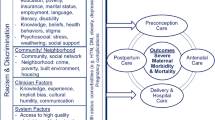Abstract
The development of a congenital heart defect (CHD) is multifactorial, with many cases having an unknown etiology. This study explored whether maternal race and lived environment were associated with an infant being born with a critical CHD. A cross-sectional, case–control design was conducted utilizing secondary data analysis. The CHD group (N = 199) consisted of infants diagnosed with a critical CHD within the first year of life identified from hospital databases. The non-CHD group (N = 548) was a random sample of infants selected from the state’s vital statistics database. The primary outcome was a critical CHD diagnosis. Maternal race, residential rurality, and the Social Vulnerability Index (SVI) were assessed for associations with a critical CHD using bivariate and multilevel regression models. Bivariate findings reported significance among residential rurality (p < 0.001), SVI ranking overall (p = 0.017), and SVI by theme (theme 1 p = 0.004, theme 2 p < 0.001, theme 3 p = 0.007, and theme 4 p = 0.049) when comparing infants with and without a critical CHD diagnosis. Results of multilevel logistic regression analyses further identified living in a rural residential area compared to urban areas (OR = 7.32; p < 0.001) as a predictor for a critical CHD diagnosis. The findings of lived environmental level associations provides information needed for continued investigation as the burden of a critical CHD continues to impact families, suggesting further research efforts are needed to improve health disparities.
Similar content being viewed by others
References
Mahle WT, Newburger JW, Matherne GP et al (2009) Role of pulse oximetry in examining newborns for congenital heart disease: a scientific statement from the American Heart Association and American Academy of Pediatrics. Circulation 120:477–458. https://doi.org/10.1161/circulationaha.109.192576
Mai CT, Isenburg JL, Canfield MA et al (2019) National population-based estimates for major birth defects, 2010–2014. Birth Defects Res 111:1420–1435. https://doi.org/10.1002/bdr2.1589
Stallings EB, Isenburg JL, Aggarwal D et al (2022) Prevalence of critical congenital heart defects and selected co-occurring congenital anomalies, 2014–2018: a U.S. population-based study. Birth Defects Res 114:29–89. https://doi.org/10.1002/bdr2.1980
Oster ME, Lee KA, Honein MA et al (2013) Temporal trends in survival among infants with critical congenital heart defects. Pediatr 131:e1502–e1508. https://doi.org/10.1542/peds.2012.3435
Martin GR, Ewer AK, Gaviglio A et al (2020) Updated strategies for pulse oximetry screening for critical congenital heart defects. Pediatr 146:e20191650. https://doi.org/10.1542/peds.2019-1650
Blue GM, Kirk EP, Sholler GF et al (2012) Congenital heart disease: current knowledge about causes and inheritance. Med J Aust 97:155–159. https://doi.org/10.5694/mja.10811
Botto LD, Correa A (2003) Decreasing the burden of congenital heart anomalies: an epidemiologic evaluation of risk factors and survival. Prog Pediatr Cardiol 18:111–121. https://doi.org/10.1016/S1058-9813(03)00084-5
Zeng Z, Zhang H, Liu F, Zhang N (2016) Current diagnosis and treatments for critical congenital heart defects. Exp Ther Med 11:1550–1554. https://doi.org/10.3892/etm.2016.3167
Yu D, Feng U, Yang L et al (2014) Maternal socioeconomic status and the risk of congenital heart defects in offspring: a meta-analysis of 33 studies. PLoS ONE 9:e111056. https://doi.org/10.1371/journal.pone.0111056
Ngwezi DP, Hornberger LK, Osornio-Vargas A (2018) The role of socioeconomic status and the development of congenital heart disease: a scoping review. Adv Pediatr Res 5(19):1–6. https://doi.org/10.24105/apr.2018.5.19
Office of Disease Prevention and Health Promotion (n.d.) Healthy people 2030: social determinants of health. https://health.gov/healthypeople/priority-areas/social-determinants-health. Accessed 5 Oct 2023
Diez Roux AV (2007) Neighborhoods and health: where are we and where do we go from here? Rev Epidemiol Sante Publique 55:13–21. https://doi.org/10.1016/j.respe.2006.12.003
Li X, Sandquist J, Hamano T, Zoller B et al (2016) Neighbourhood deprivation, individual-level and familial-level socio-demographic factors and risk of congenital heart disease: a nationwide study from Sweden. Int J Behav Med 23:112–120. https://doi.org/10.1007/s12529-015-9488-9
Knowles RL, Ridout D, Crowe S et al (2017) Ethnic and socioeconomic variation in incidence of congenital heart defects. Arch Dis Child 102:496–502. https://doi.org/10.1136/archdischild-2016-311143
Rural Health Information Hub (2022) Rural health disparities [online]. www.ruralhealthinfo.org/topics/rural-health-disparities#causes. Accessed 5 Oct 2023
Rural Health Information Hub (2024) Need for maternal health programs in rural areas [online]. www.ruralhealthinfo.org/toolkits/maternal-health/1/need-in-rural. Accessed 2 Feb 2024
Larsson LS, Butterfield P, Christopher S et al (2006) Rural community leaders’ perceptions of environmental healht risks: improving community health. AAOHN 54:105–112
Agha MM, Glazier RH, Moineddin R et al (2011) Socioeconomic status and prevalence of congenital heart defects: does universal access to health care system eliminate the gap? Birth Defects Res 91:1011–1018
Egbe A, Uppu S, Lee S et al (2014) Changing prevalence of severe congenital heart disease: a population-based study. Pediatr Cardiol 35:1232–1238. https://doi.org/10.1007/s00246-014-0921-7
Peyvandi S, Baer R, Chambers C et al (2020) Environmental and socioeconomic factors influence the life-born incidence of congenital heart disease: a population-based study in California. J Am Heart Assoc 9:e015255. https://doi.org/10.1161/JAHA.119.015255
Miao Q, Dunn S, Wen SW et al (2021) Neighbourhood maternal socioeconomic status indicators and risk of congenital heart disease. BMC Pregnancy Childbirth 21:72. https://doi.org/10.1186/s12884-020-03512-8
Acknowledgements
The first author was a participant in the 2022 NLN Scholarly Writing Retreat, sponsored by the NLN/Chamberlain University College of Nursing Center for the Advancement of the Science of Nursing Education
Author information
Ethics declarations
Competing interests
The authors declare no competing interests.
Additional information
Publisher's Note
Springer Nature remains neutral with regard to jurisdictional claims in published maps and institutional affiliations.
Rights and permissions
Springer Nature or its licensor (e.g. a society or other partner) holds exclusive rights to this article under a publishing agreement with the author(s) or other rightsholder(s); author self-archiving of the accepted manuscript version of this article is solely governed by the terms of such publishing agreement and applicable law.
About this article
Cite this article
Hall, K.C., Robinson, J.C., Karimi, M. et al. Effect of Maternal Race, Residential Rurality, and Social Vulnerability on Critical Congenital Heart Defect Risk. Pediatr Cardiol (2024). https://doi.org/10.1007/s00246-024-03472-2
Received:
Accepted:
Published:
DOI: https://doi.org/10.1007/s00246-024-03472-2




